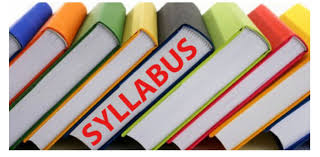WAEC Visual Arts Syllabus 2025/2026
Read this WAEC Visual Arts Syllabus 2025/2026 to help you study effectively and perform well on tests. General knowledge, West African art, graphics, painting, drawing, and art history are just a few of the many subjects covered in the WAEC Visual Arts curriculum.
It is intended to provide you with a general understanding of the fine arts and their applications in creative expression and idea communication.
- WAEC Physics Syllabus 2025/2026
- WAEC Islamic Religious Studies (IRS) Syllabus 2025/2026
- WAEC Music Syllabus 2025/2026
Get it now!
We would suggest that you enrol in Visual Arts at WAEC if you plan to study courses like Creative Arts, Fine Arts, Performing Arts, etc., as these courses require you to have some kind of artistic expression and creative thinking.
- Section A: Artistic general knowledge;
- Section B: West African Art;
- Section C: Prehistoric art,
- Ancient Egyptian art and Western Art.
There will be eight essay questions in all. Applicants will be
Required to answer four questions selecting two questions from Section B, one from Section C, and one from Section A. The two-hour paper will be worth sixty marks.
The general knowledge of art, including its elements and principles, branches, processes, history, and appreciation, as well as creative design processes, will be the main focus of Papers 1 and 2. Tests on how to use and maintain art supplies and tools will also be part of them.
Contents
WAEC Visual Arts Syllabus 2025/2026
| WAEC VISUAL ART SYLLABUS | ||
| SN | TOPICS | OBJECTIVES |
| PAPER I & II | ||
| 1 | GENERAL KNOWLEDGE IN ART | i. Nature and branches of Art and careers in art; ii. Visual awareness, understanding and appreciation of Art elements, their forms, characteristics and functions e.g. line, colour, space, shape, form, texture, etc.; iii. Principles of Art – creative application of art and design principles e.g. balance, rhythm, proportion, harmony, emphasis, variety, etc. iv. Perspective – meaning and type e.g. aerial, linear (angular/parallel) and foreshortening. v. The knowledge of production, use and care of art/craft tools and materials e.g. brushes, pencils, colour, palettes, easels, etc; vi. Art and craft terms e.g. tie and dye, biscuit ware, silhouette, relief, chiaroscuro, sfumato, aperture, etc; vii. The inter-relationships of the arts e.g. music, visual art, dance, drama and literary arts. |
| 2 | ART OF WEST AFRICA | i. Ancient Traditional Art Cameroon – Bamileke Dahomey (Now Benin Republic) – Fon Gambia – Wollof, Mandinka, Jola Ghana (Formerly Gold Coast) – Ashanti, Fante, Ewe, Frafra Guinea – Kissi Cote d’Ivoire (Ivory Coast) – Senufo, Baule Liberia – Dan and Ngere Mali – Dogon, Bambara Sierra Leone – Mende, Sherbro Upper Volta (Now Burkina Faso) – Mossi, Bobo, Kurumba Nigeria – Benin, Ife, Nok, Igbo-Ukwu, ii. Modern Traditional Art Oshogbo art, Ashanti and Ewe Kente, Modern Benin art, Winneba pottery, Abuja pottery, Ntoso adinkra, Bida brass works, calabash carving, Enyiresi basketry, Mbari mud sculpture, weaving, leatherwork, wall decoration, indigenous Decorative Motifs. iii. Contemporary (a) Art institutions (art schools, art galleries, arts centres, museums). Various departments responsible for art and culture, Art organizations, e.g INSEA (International Society for Education through Art), NSIAD (Nigeria Society of Industrial Artists and Designers), Ghana Artists Association, Ghana Craftsmen Association, Ghana Arts Council, GAT (Gambia Art Teachers Association), NAAC (National Association of Artists and Craftsmen) SNA (Society of Nigerian Artists), NSEA (Nigerian Society of Education through Art), Ona Art Movement of Artists, Ulli Art Movement, The Eye Society. Cultural festivals (their artistic significance e.g. costumes, symbols, objects, masks, body decorations, wall decorations, etc). (b) Outstanding contemporary West African Artists: their training, style, achievements and contributions to the development of art. |
| 3 | PRE-HISTORIC, ANCIENT EGYPTIAN AND WESTERN ART | i. Pre-historic (Earlyman’s Art 20,000 – 2000BC) (Paleolithic, Mesolithic and Neolithic stone Ages) beliefs, materials, characteristics and functions; ii. Ancient Egyptian art 11,000 – 7,000 BC (Old, Middle and New Kingdoms) beliefs, styles and functions; iii. Greek Art – Periods and charctreristics; iv. Medieval Art – Features, media and characteristics v. 19th Century Art (a) Impressionism – Artists – Paul Cezanne, Claude Monet, Edouard Manet, Georges Seurat. (b) Post Impressionism (late 19 century)- Artists – Vincent van Gogh, Paul Gauguin etc. vi. Renaissance Art Early, Low and High Renaissance Art – Artists: Giotto, Donatello, Masaccio, etc. vii. Medieval Art: Features (characteristics). viii. Greek Art: Periods (Archaic, Classical and Hellenistic), characteristics and artists. ix. 20th Century Art Cubism: Influence of African Art and Artists – Pablo Picasso, George Braque. |
| 4 | PAPER III: DRAWING | i. Drawing from Objects: The aim of this alternative is to test candidates’ ability to observe and interpret a group of arranged objects as a total composition. It will require a drawing of a group of man-made objects. The work may be carried out in relation to the surroundings or the part of the room in which the objects are placed. The drawing may include objects such as old radio sets, parts of cars, bicycles, machines, bottles, etc. ii. Drawing from Nature: The purpose of this alternative is to get candidates to make a study of natural objects to bring out the beauty of their forms and/or the nature of their growth. This may require the study of a branch which may include flowers, foliage, fruits and vegetables. It may also be the study of rocks, bones, insects and birds, shells and other forms including fish, crustacean, skeleton etc. iii. Drawing from Life: The aim of this alternative is to test candidates’ ability to observe and depict accurately, the structure and form of a living person. The model (male or female) is to be posed in an attitude which will be described. The figure must be drawn as may be instructed. |
| 5 | PART B: CREATIVE ART (2-DIMENSIONAL ART) | i. Graphics Design a) Lettering and poster design This includes: the design and layout of a brief notice requiring formal lettering, which may be in Roman, Gothic or any other formalized characters; creation of pictorial posters with suitable lettering; lettering and layout appropriate for purposes such as greeting cards, formal invitations and book jackets, logo types, emblems, symbols, labels, wall hangings etc. b) Book Illustration – This includes story and text illustrations in books, magazines and newspapers. c) Printmaking – This includes linocut, woodcut, yam print, stenciling, screen printing and others. d) Package Design – e.g. wrappers, cereal packages and record (CD) jackets etc; e) Computer Graphics – Designing any of (i – iv) with the use of computer software e.g. CorelDraw, Adobe Photoshop etc. ii. Textile Design Designing a piece of material such as cotton, or silk, dyed in a pattern as in batik, tie and dye or printed as in block or screen printing. The piece should be at least two metres in length and unsewn. This section will also involve the following: a) Appliqué – shaped fabric pieces sewn on a foundation fabric to form a Design or pattern. b) Tapestry – a piece of fabric with a woven pattern or picture used as wall hanging, upholstery, etc. iii. Picture Making Questions on picture-making are meant to test candidates’ creative sense, ability and technical proficiency in the execution of the under-listed areas: a) Painting – Creating illustrative composition of ideas (themes) from everyday life or imagination, using suitable medium. This shall include Mural. b) Photography – the art of producing pictures with camera. The purpose of this aspect is for candidates to be able to demonstrate basic knowledge and creative skill in shooting and printing of pictures from a variety of subjects such as: Portraits – – – – human compositions Landscape – – – – rocks, hills, anthills, buildings, street scenes, etc Seascape – – – – beach scenes, streams, waterfall, dams etc. Nature – – – – plants, leaves, flower foliage, twigs, fruits, etc. Pets – – – – – . cats, dogs, birds etc. N.B: Experimental photography with simple forms of photo tricks e.g. photo grams and image distortion in printing etc. is encouraged. c) Mosaic – making picture with small pieces of regular shaped coloured materials e.g. glass, paper or tile stuck onto a surface. d) Collage – making pictures by synthesizing a variety of irregular shaped materials like cloth, pieces of paper and other objects onto a surface. |
| 6 | PART C: CREATIVE DESIGN (3-DIMENSIONAL ART) | i.Sculpture:This may be rendered in clay, metal, wood, papier-mâché, cement, etc. All works rendered in clay must be fired. ii. Product Design/Modeling: Designing and producing models of industrial products, such as automobiles, phones, bottles, cosmetics, etc. iii. Ceramics: Ceramic wares such as jugs, flower vase, bowl, etc which a candidate has either moulded, handbuilt or thrown on the wheel or any other object such as a toy animal or figure. Clay works must be fired. iv. Crafts: This shall include: a) Basketry: the making of mats, chair, hat, stool, bag, macramé or other useful objects designed and woven or plaited in cane, raffia, etc. b) Jewellery: the design and construction of ornaments with metals, beads, plastic, shells, seeds, etc. c) Calabash Decoration: Designing and decorating calabash using various method. |
2025/2026 Recommended WAEC Visual Arts Textbooks
- Amenuke, S.K., B. K. Dogbe et al General Knowledge in Art for Senior Secondary Schools. Ministry of Education, Accra, Ghana
- 2. E. H. Gombrich The Story of Art Phaidon Press Limited l
- 3. Hellen Gardner Art Through the Agers Harcourt, Brace & World, N.Y. 1980
- 4. Kofi Antubam Ghana’s Heritage of Culture
- 5. Bernard S. Mayers Art & Civilization McGraw Hill, New York
- 6. Harlow Art History in Africa Longman Group Limited
- 7. Robert Clement The Art Teacher’s Handbook Century Hutchinson Limited, London
- 8. Harry Stemberg Composition Grosset & Dunlop New York
- 9. Maurice De Samsmarez Basic Design: The Dynamics of Visual Form Studio Vista Limited, London
- 10. Harold Osborne Art of Appreciation Oxford University, London
- 11. Henry Pluckrose The Book of Crafts Evans Brothers Limited, London
- 12. Werner Gillon A Short History of African Art Penguin Books Limited, Harmondsworth, U.K.
- 13. Whitfield Beginning Pen lettering (Book 3) Gina and Company Ltd, London.
- 14. Ayisi, Eric, O. An Introduction to the Study of African Culture Heinemann, 1972
- 15. Beier, Ulli Art in Nigeria London, Cambridge University Press, 1960
- 16. Olaosebikan, W.A. Cultural & Creative Arts: A Source Book for Teachers Ibadan: Evans
- 17. Underwood, Leon Bronzes of West Africa Transatlantic Art 1968
- 18. Wangboje, S. J. A Textbook on Art for Senior Secondary School Evans Brother (Nig.) Ltd, 1982
- 19. Frank Willett Ife and the History of West African Sculpture Thames and Hudson, 1967
- 20. Pat Oyelola Nigerian Crafts Macmillian 1981
- 21. George Talabi Art Teaching in African Schools Heinemann Educational Books, Ibadan
- 22. Frank Willett African Art Thames and Hudson
- 23. Ibrahim Banjoko Cultural and Creative Arts
- 24. Emu Ogumor Certificate Art for Junior and Senior Secondary Schools University Press 2007
- 25. Uzoagba, I. N. Understanding Art in General Education African First Publishers Ltd, 2008
- 26. Filani Kunle Patterns of Culture in Contemporary Yoruba Art Symphony Books 2005.
Conclusion
To prepare for the upcoming West African Senior School Certificate Examination (WASSCE), do you need the most recent syllabus? If so, you’ve found what you were looking for.
You’ve learned almost everything you need about the subject you registered for from these syllabi, WAEC Visual Arts Syllabus 2025. which also serves as your guide to answering WAEC questions. They are meticulous, precise, and well-structured. They serve as a communication channel between test-takers and the West African Examinations Council (WAEC).
Every year, we also learned the causes of subpar performance on the WAEC exams. Our findings helped us to realize that students’ poor performance on the WASSCE is caused by their ignorance of common pitfalls, insufficient syllabus coverage, and unfamiliarity.


